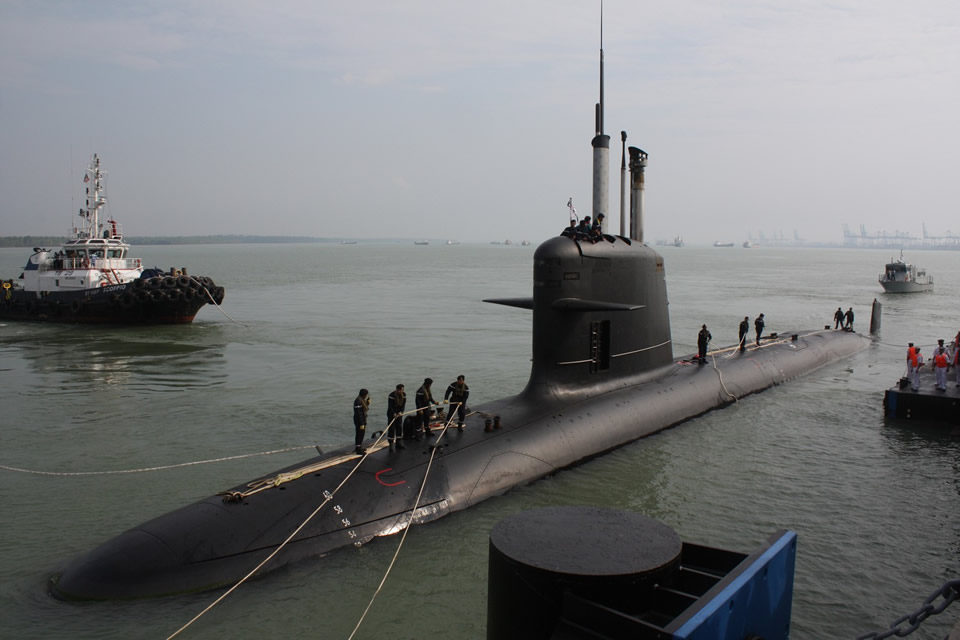 Bowed to pressure from the Navy, India’s ministry of defense (MoD) has ruled that foreign and government owned shipyards will be allowed to compete for the construction of new Project 75I submarines. In contrast to previous policy, MoD determined that no private sector shipyard in the country has the infrastructure and capability required for building the next generation conventional submarines that the Indian Navy wants. As a result, the long-delayed plan to build six conventional submarines for an estimated Rs 30,000-35,000 crore (about US$6 billion) will be divided between foreign shipyards and the defense public sector.
Bowed to pressure from the Navy, India’s ministry of defense (MoD) has ruled that foreign and government owned shipyards will be allowed to compete for the construction of new Project 75I submarines. In contrast to previous policy, MoD determined that no private sector shipyard in the country has the infrastructure and capability required for building the next generation conventional submarines that the Indian Navy wants. As a result, the long-delayed plan to build six conventional submarines for an estimated Rs 30,000-35,000 crore (about US$6 billion) will be divided between foreign shipyards and the defense public sector.
According to Secretary of Defence for Production, Shekhar Agarwal, two Project 75I submarines will be built abroad by the foreign vendor that wins the MoD contract with the follow-on four vessels to be constructed in India, by the Mazagon Dock Limited, Mumbai (MDL) and Hindustan Shipyard Ltd, Visakhapatnam (HSL).
This decision is a blow to the private sector shipyards. Larsen & Turbo (L&T) shipyard. The company is playing a major role in building the Arihant-class nuclear submarines. ABG Shipyard and Pipavav Shipyard have also invested on infrastructure in preparation for major defense contracts. According to the long-term Submarine Construction Plan introduced in 1999, Indian shipyards would build 24 conventional submarines by 2030. The latest MoD decision to build two submarines abroad runs contrary to this plan.
The Indian Navy insists that the lead Project 75I submarines will be built abroad, preventing the delays it is experiencing with its current Project 75 (Scorpene) class. Project 75 involves the construction of six Scorpene submarines in MDL, in partnership with Franco-Spanish consortium DCNS. The first Scorpene, which was to be delivered this year, will only be completed in 2015. With P75 subs delayed, the next Project 75I project is still in RFI phase, with both French (AIP Scorpene) and the Russian (Amur 1650 class) being considered though the massive technology transfer expected to deliver through the current phase will make Scorpene significantly more competitive in a future competition.
In 2005 India and French firm DCNS have signed the contract for the construction of the six submarines and transfer of technology from DCNS. The cost of the program is worth over project Rs 23,000 crore ($4.6 billion).
The program encountered significant delays in qualifying local subcontractors and suppliers to deliver parts for the submarines. Last month, seven years after the contract was signed DCNS has announced the supply of the first lot of India-made equipment to MDL, for installation on these Scorpene submarines. The equipment was manufactured by Indian firm Flash Forge India Pvt Ltd based out of Vishakhapatnam. “We are providing know-how and technical assistance to our Indian partners, and with MDL, we are qualifying suitable companies which are meeting the specifications needed for the submarines” explained Bernard Buisson, Managing Director of DCNS India. He acknowledged that due to delays in procurement of MDL-purchased items, the delivery schedule of the Scorpenes has been adversely affected and the first of it is commissioned only in 2015.
The Scorpene is a 1,700-tonne submarine that can remain at sea for 40-50 days. India has an option to install Air Independent Propulsion (AIP) systems in the last two Scorpenes that MDL builds, and then retrofit AIP into the other four Scorpenes as well.
The submarine designer, the French company DCNS is displaying at Defexpo 2012 two new technologies addressing this submarine – the SUBTICS integrated combat system and the MESMA – an Autonomous Submarine Energy Module (also referred to as AIP).
SUBTICS combines long-range capabilities in all navigation conditions with powerful weapons (torpedoes, anti-ship missile, counter-measures, land-attack capability). As a fully-integrated system, all functions are operated from Multifunction Common Consoles and its open architecture and modularity guarantee that the system can be adapted to every type of submarines and configured according to operational requirements. It can also be upgraded during its lifetime to fulfill new missions and keep its operational superiority.
The MESMA is an electrical energy production module designed specifically for conventional submarines. As well as supplying electricity to the vessel and to the propulsion system, it can also be used to recharge the batteries without the need to surface. Together with a MESMA section, a Scorpene will be able to carry out extended missions with an over 3 weeks submerged endurance. The 10 meters’ MESMA module can be considered as a new-build option or installed during an upgrade.

















